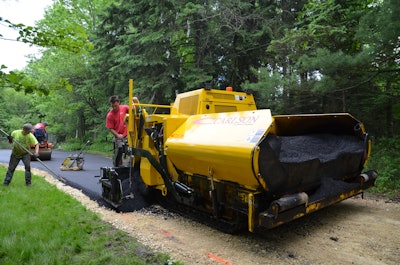
Contractors paving residential driveways face a broad range of challenges but one of the most perplexing is how to pave and construct unsupported edges so they make the finished job look great and last a long time.
If you’re paving against a concrete patio or the side of house, the edge of your mat is not much of an issue. But when you don’t have an edge to pave against it’s important you set up a stringline so the operator has something to follow and to aim for. Setting up a stringline is a simple operation that not only provides the map for the operator but will let you know in advance of any unexpected challenges you might encounter. Are there plants in the way? Do you need to bend the stringline around an object? How do you want the operator to handle that?
A good paver operator can easily follow the stringline to construct a nice straight edge. Without a stringline the edge will almost certainly be uneven and have wobbles in it, and because it’s unsupported those defects will be easy for the homeowner to spot.
Setting up a stringline will also help you “design” the driveway so it looks good. Do you need to shape the driveway where it flares out? The driveway might be 10 ft. wide all the way out but you might need a nicely shaped curve that flares from 10 to 16 ft. wide at the end where you back out into the street and so a vehicle doesn’t back over the grass. A stringline will help you shape the job and will make sure you think the project through before you start placing mix.
Using a stringline isn’t important only if the driveway offers a nice, straight shot from the garage to the street. If you’re driving the paver all over the place or if you have no stringline to follow, the edge will meander.
Once the edge is constructed compact it with either a 36-in. lute (cleaned and lubricated) or a tamper maul. In addition to maintaining the straight edge the paver has placed, try to compact the edge on a 75-degree angle so that when the customer sees it it looks nice and straight and clean.
Other Edge Options
That’s the manual approach and the approach most-often used by contractors.
But paver manufacturers have enhanced their equipment to help contractors construct perfect edges. Carlson Paving Products, for example, offers its Safety Edge, which actually drops below the mat and actually seals the edge as the paver moves along. That means you don’t have to cut the edge as you go along and you don’t have to tamp it because the Safety Edge has already sealed it.
Another approach is to rely on heated end gates, which are available on any paver. These heated end gates heat the mix at the end -- just like the screed is heated. The heated end gates heat the mix on the ground at the edge of the mat. The edge is sealed because the mix can’t go anywhere because it’s contained by the end gates. The combination of the pressure in the contained mix and the heat seals the edge.
Technical Tips
And regardless of which approach you use to place mix at the edge of the driveway, use vibration on the screed. Many contractors forego this option on driveway work, thinking that vibration is not as necessary as on a parking lot or road. But that’s not the case. Using vibration on the screed enables much better compaction at the end gate.
Monitor the paver’s feed system. This is the system that brings the mix from the hopper to the screed and eventually to the end gates. If you don’t pay attention to the feed system on the paver, and if the mix is flowing through the system unevenly, an uneven amount of mix will be delivered to the screed. This will cause a problem in the center of the mat but it will cause an even bigger problem at the edge because less mix will be delivered there. You’ll have an inconsistent amount of mix at the edge, which will make your edge uneven and inconsistent, too.
Screed Maintenance
Maintenance important, particularly where it concerns the screed. First, make sure end gate bolts are in place (they do tend to loosen and get lost). If they aren’t there, replace them. If they are there make sure they are tight because if they’re loose (or if they are missing) the end gates won’t hold the edge. The gates will slide up and down or back and forth. The edge won’t stay solid for you if the bolts are missing or loose.
John S. Ball is president of Top-Quality Paving, P.O. Box 4398, Manchester, NH 03104; [email protected].












![Lee Boy Facility 2025 17 Use[16]](https://img.forconstructionpros.com/mindful/acbm/workspaces/default/uploads/2025/09/leeboy-facility-2025-17-use16.AbONDzEzbV.jpg?ar=16%3A9&auto=format%2Ccompress&fit=crop&h=135&q=70&w=240)








